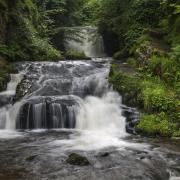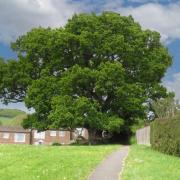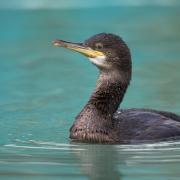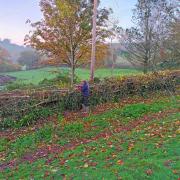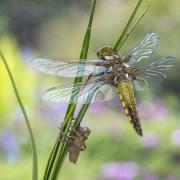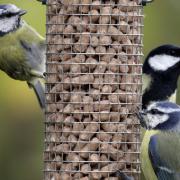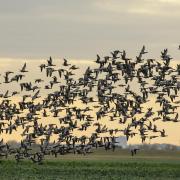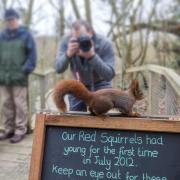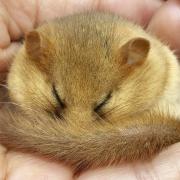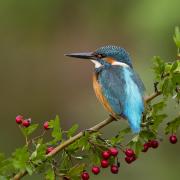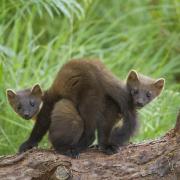In advance of this year's RSPB Big Garden Birdwatch, Tony Whitehead shares a passion for the birds in his South Devon garden
Our garden is a modest size; a small well-trodden lawn with a trampoline for the children, a few borders and flower beds, and a very aged greenhouse. All around is a variety of tallish trees and bushes that give it a jungle-like feel at times. We hang feeders from these, one set at the far end of the garden, one near the kitchen window.
Try to remember we are giving the birds a helping hand, not making them dependant
As advised nowadays, we feed the birds throughout the year. I suppose it’s become something of a moderate obsession. We don’t overdo it, of course, we try to remember we are giving the birds a helping hand, not making them dependant. But every morning the feeders are refilled with sunflower hearts and a ‘breakfast mix’ of live mealworms, fruit and suet pellets are scattered along the path and the edges of the flower beds. That done, the water is topped up and any excess seed waste brushed up.
This feeding ritual complete, we retreat to the kitchen. Within minutes the birds start to reappear, first at the tops of the taller trees and overhead wires, then down through the lower bushes and on to the feeders and path. Goldfinches and greenfinches are most numerous, followed by our blackbirds, and increasingly a flock of rather garrulous starlings. Our two woodpigeons may put in an appearance, and every now and then blue, great and coal tits drop onto the peanuts. In amongst the hubbub, our resident robins hop around, picking up the live mealworms wriggling along the path.
We like our regulars. We feel as though we are getting to know them as individuals – especially of course those with distinctive features. The friendly robin with the square-ish head, the house sparrow with white wing feathers, and best of all a rather tatty-looking blackbird who worked and worked throughout the spring to raise a couple of broods of youngsters. But we also enjoy the unusual, of which 2010 provided plenty.
Within minutes the birds start to reappear, first at the tops of the taller trees and overhead wires, then down through the lower bushes and onto the feeders and path
The snows of last winter in particular provided a treat in the form of a flock of fieldfare that temporarily took up residence. These migrant thrushes are striking birds with blue-grey heads and rumps. As all the books say, they love apples! Indeed, in all the time they were in the garden it’s the only thing I saw them eat. Not only were the fieldfare good to look at, they also sounded quite distinctive too, their repeated ‘chack-a-chack’ calls alerting us to their arrival.
Occasionally they brought with them a mistle thrush, another new bird to the garden. The largest of all the UK thrushes, our individual also developed rather a taste for the fruit, but wasn’t too keen on sharing with others as he (or she) maintained a very distinct, small feeding territory. Up above the fieldfare we also welcomed a pair of blackcaps, male and female. These warblers have over the past 15 years started to regularly winter in the south of England, flying in from Germany and Austria rather than make the more traditional journey south to the Iberian Peninsula. It’s good to have them around. Although in no way colourful, there’s a certain elegance about them. And for the record, it’s the males that have the black cap; the females have a brown cap.
As winter passed and the fieldfares flew back north to nest (as we imagined, in some leafy Scandinavian park), the garden came alive with bird song and birds doing their best to make a good impression on one another.
In amongst the hubbub, our resident robins hop around, picking up the live mealworms wriggling along the path
We’d had bullfinch visiting throughout the winter, but it now looked like we had two distinct pairs. As in the previous year, we waited and waited for the first visits of youngsters. And like last year we forgot just how long this took – it wasn’t until July that the first dumpy young bullfinches appeared. Lacking their parents’ black caps, and colour, they sat unperturbed for ages on the bird tables happily munching away at the seed.
This was a distinct highlight. Prior to the ’90s, bullfinches rarely put in an appearance on the bird table, or indeed in gardens at all. Although not actually in the garden, a highlight of the late summer was the appearance of young buzzards around the field opposite our house. In particular we had one dozy youngster who seemed little bothered by either us or passing cars, and who regularly perched on an old dead tree looking to all the world as though he wasn’t quite sure what being a buzzard actually entailed.
However, it was a bird of prey that knew exactly what it was about that provided a regular, but rather gruesome highlight in the garden as autumn turned to winter. We’d seen sparrowhawks flying around quite regularly, and last winter we had one perch briefly by one of the feeders, but it wasn’t until the latter part of the year that we saw one actually take a bird from the garden.
The first encounter was watching a youngish bird perched on a pile of garden rubbish busily plucking what looked like a starling. Caught in the act, as soon as the bird saw us it took to the wing and flew off over the house. The second and more dramatic encounter was with a bird, another youngster, flying into the kitchen window clutching a starling and then flopping onto our garden path rather dazed, still holding said starling. After a short while, the bird came round but lost hold of the starling, which made a wise getaway.
These encounters with sparrowhawks give rise to a variety of emotions. On the one hand we’d really rather they didn’t take the starlings or blackbirds we’ve been enjoying throughout the year, but on the other hand they are predators and it’s not up to us to deny them what is, after all, their food.
And we know there is precious little evidence of any sort that they impact on bird populations as a whole. Indeed, quite the opposite is probably true. The fact that we have a healthy songbird population locally is indicated by the presence of sparrowhawks. Remember, in ecological terms, the quality and abundance of prey always determines the size of predator populations and not the other way round.
These thought-provoking experiences, or the spectacle of a new or unusual bird, are amongst the many pleasures of feeding garden birds. But more than this, it’s just the simple company of birds that we find most satisfying, just having them around every time we glance out of the kitchen window, a daily reminder that birds are one of the few truly wild creatures we regularly share our lives with.
BIG GARDEN BIRDWATCHEvery year at the end of January, the RSPB holds its annual Big Garden Birdwatch. Taking part is simplicity itself – just take an hour over the Birdwatch weekend and record the different species that appear in that hour, and the maximum number at any one time. Send the results in so we can produce a report that lists the most common birds and, by looking back over previous reports, their trends. rspb.org.uk/birdwatch



